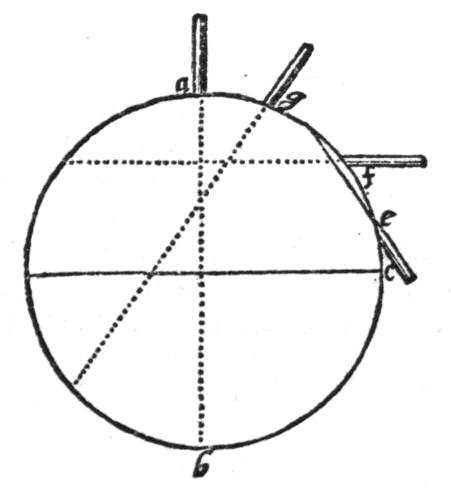why at the pole itself the coition is stronger than in the other parts intermediate between the æquator and the pole; and on the proportion of forces of the coition in various parts of the earth and of the terrella.
o bservation has already been made that the highest power of alluring exists in the pole, and that it is weaker and more languid in the parts adjacent to the æquator. and as this is apparent in the declination, because that disponent and rotational virtue has an augmentation as one proceeds from the æquator towards the poles: so also the coition of magneticks grows increasingly fresh by the same steps, and in the same proportion. for in the parts more remote from the poles the loadstone does not draw magneticks straight down towards its own viscera; but they tend obliquely and they allure obliquely. for as the smallest chords in a circle differ from the diameter, so much do the forces of attracting differ between themselves in different parts of the terrella. for since attraction is coition towards a body, but magneticks run together by their versatory tendency, it comes about that in the diameter drawn from pole to pole the body appeals directly, but in other places less directly. so the less the magnetick is turned toward the body, the less, and the more feebly, does it approach

and adhære. oblique magnetics. just as if a b were the poles and a bar of iron or a magnetick fragment c is allured at the part e; yet the end laid hold of does not tend towards the centre of the loadstone, but verges obliquely towards the pole; and a chord drawn from that end obliquely as the attracted body tends is short; therefore it has less vigour and likewise less inclination. but as a greater chord proceeds from a body at f, so its action is stronger; at g still longer; longest at a, the pole (for the diameter is the longest way) to which all the parts from all sides bring assistance, in which is constituted, as it were, the citadel and tribunal of the whole province, not from any worth of its own, but because a force resides in it contributed from all the other parts, just as all the soldiers bring help to their own commander. wherefore also a slightly longer stone attracts more than a spherical one, since the length from pole to pole is extended, even if the stones are both from the same mine and of the same weight and size. the way from pole to pole is longer in a longer stone, and the forces brought together from other parts are not so scattered as in a round magnet and terrella, and in a narrow one they agree more and are better united, and a united stronger force excels and is preeminent. a much weaker office, however, does a plane or oblong stone perform, when the length is extended according to the leading of the parallels, and the pole stops neither on the apex nor in the circle and orbe, but is spread over the flat. wherefore also it invites a friend wretchedly, and feebly retains him, so that it is esteemed as one of an abject and contemptible class, according to its less apt and less suitable figure.
